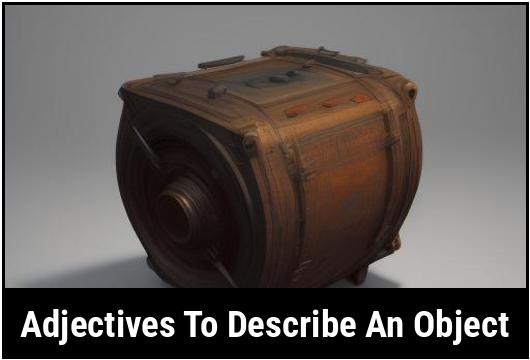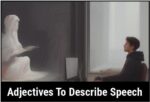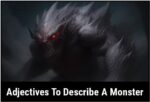- You are here:
- Home »
- adjectives
- » 31 Adjectives To Describe An Object

31 Adjectives To Describe An Object
Describing an object with precision not only helps in effective communication but also adds color and depth to our language. Adjectives play a crucial role in painting a vivid picture of an object in the minds of the listeners or readers. They bring life to otherwise mundane sentences and serve as a powerful tool for expression. This article delves into the importance of using adjectives to describe an object, the different types of adjectives, and how to choose the right one for the given context.
Key Takeaways
- Adjectives serve to provide details, characteristics, and qualities of an object.
- Using the right adjectives can make the description more vivid and engaging.
- By understanding the types of adjectives, one can effectively choose the most appropriate one for a given situation.
Adjectives To Describe An Object
1. Exquisite
When an object is described as exquisite, it implies that it possesses a rare beauty and exceptional craftsmanship. This adjective evokes an image of refinement, elegance, and precision, highlighting the intricate details and flawless design of the item.
2. Resilient
Resilient objects are built to withstand the test of time and retain their functionality and appearance even under challenging conditions. Whether it’s a durable kitchen appliance or a sturdy outdoor tool, using the word resilient emphasizes the longevity and reliability of the object.
3. Sleek
Sleek objects are characterized by their smooth and polished appearance. They often have a minimalist design, combining simplicity and elegance effortlessly. Describing an object as sleek conveys a sense of modernity, sophistication, and a seamless integration of form and function.
4. Versatile
An object that is versatile is capable of adapting to various situations or fulfilling multiple purposes. This adjective is perfect for describing tools, gadgets, or furniture items that offer flexibility and practicality, making them suitable for a wide range of needs.
5. Innovative
Innovation is a driving force behind progress, and an innovative object represents the cutting edge of its field. This adjective implies that the item incorporates new ideas, technologies, or features that set it apart from its counterparts, ultimately enhancing user experience and pushing boundaries.
6. Timeless
Certain objects transcend the limitations of time and remain relevant and cherished throughout generations. Describing an object as timeless indicates that it possesses a certain classic appeal, never going out of style and retaining its uniqueness and allure.
7. Ergonomic
An object that is ergonomic prioritizes user comfort and efficiency. This adjective suggests that the item has been designed with human needs in mind, offering optimal usability, reducing strain, and enhancing overall well-being.
8. Luxurious
Luxurious objects exude opulence and indulgence, often associated with wealth and high-end quality. When describing an item as luxurious, you emphasize its premium materials, meticulous attention to detail, and the sense of exclusivity it provides.
9. Vibrant
Vibrant objects burst with energy, color, and life. This adjective is great for describing items that are visually striking, with bold hues and dynamic patterns that captivate the beholder’s attention.
10. Whimsical
Objects that are whimsical possess a playful and fanciful nature, often characterized by their imaginative design and unexpected elements. Describing something as whimsical introduces an element of charm and lightheartedness, making it captivating and delightful.
11. Reliable
When an object is described as reliable, it means that it can be trusted to perform consistently and deliver the expected results. Reliability is a desirable trait for products and tools, highlighting their dependability and trustworthiness.
12. Eco-friendly
In an increasingly environmentally conscious world, eco-friendly objects are gaining popularity. This adjective suggests that an item is designed with minimal impact on the environment, promoting sustainability and aligning with eco-conscious principles.
13. Innovative
Innovation is a driving force behind progress, and an innovative object represents the cutting edge of its field. This adjective implies that the item incorporates new ideas, technologies, or features that set it apart from its counterparts, ultimately enhancing user experience and pushing boundaries.
14. Multifunctional
A multifunctional object is versatile, capable of fulfilling different purposes or adapting to various scenarios. Describing an item as multifunctional emphasizes its adaptability and efficiency while maximizing its usability and overall value.
15. Majestic
Majestic objects possess a grandeur and awe-inspiring quality that evokes a sense of dignity and power. Whether it’s an architectural masterpiece or an exquisite piece of art, using majestic to describe an object enhances its ability to command attention and admiration.
16. Efficient
Efficient objects are designed to optimize performance while minimizing waste, effort, or resources. Describing something as efficient emphasizes the effectiveness and productivity it offers, making it highly desirable and valuable.
17. Innovative
Innovation is a driving force behind progress, and an innovative object represents the cutting edge of its field. This adjective implies that the item incorporates new ideas, technologies, or features that set it apart from its counterparts, ultimately enhancing user experience and pushing boundaries.
18. Compact
An object that is compact is cleverly designed to fit into a smaller space or be easily carried around. This adjective is ideal for describing portable gadgets or lightweight tools that provide convenience without sacrificing functionality.
19. Charming
Charming objects possess an enchanting and delightful appeal, often evoking a sense of nostalgia or romanticism. Describing something as charming highlights its ability to captivate hearts and create a warm and inviting atmosphere.
20. Modern
Objects that are described as modern reflect the contemporary tastes and design trends of the time. This adjective suggests that the item incorporates current aesthetics, materials, or technologies, aligning with a progressive and forward-thinking mindset.
21. Luxurious
Luxurious objects exude opulence and indulgence, often associated with wealth and high-end quality. When describing an item as luxurious, you emphasize its premium materials, meticulous attention to detail, and the sense of exclusivity it provides.
22. Cozy
A cozy object creates an atmosphere of comfort, warmth, and relaxation. This adjective is perfect for describing items such as blankets, cushions, or furniture that invite you to snuggle up and enjoy moments of tranquility.
23. Stylish
An object described as stylish incorporates aesthetic appeal and fashion-forward design. This adjective suggests that the item is visually pleasing and on-trend, making a statement and enhancing the overall aesthetic of its surroundings.
24. Exquisite
When an object is described as exquisite, it implies that it possesses a rare beauty and exceptional craftsmanship. This adjective evokes an image of refinement, elegance, and precision, highlighting the intricate details and flawless design of the item.
25. Nostalgic
Nostalgic objects evoke sentimental feelings related to the past, reminding us of cherished memories and simpler times. Using this adjective adds an emotional depth and connection to the item, making it resonate with individuals who appreciate sentimental value.
26. Cutting-edge
A cutting-edge object represents the forefront of technological advancement or contemporary design. This adjective implies that the item is at the pinnacle of innovation, setting new benchmarks and challenging existing norms.
27. Durable
A durable object is built to withstand wear and tear, maintaining its functionality and appearance over an extended period. Describing something as durable emphasizes its ability to withstand daily use and resist damage, ensuring its longevity and value.
28. Playful
A playful object sparks joy and inspires a sense of fun and lightheartedness. This adjective implies that the item encourages interaction, creativity, or spontaneity, making it appealing to individuals who embrace a playful mindset.
29. Effortless
Effortless objects are designed to be intuitive and easy to use or maintain. Describing something as effortless emphasizes its user-friendly nature, allowing individuals to engage with the item without unnecessary hassle or complication.
30. Classic
Classic objects have stood the test of time and continue to be recognized as enduring symbols of style and taste. Describing an item as classic highlights its timeless appeal, transcending trends and remaining relevant across generations.
31. Sustainable
Sustainability has become a crucial consideration in today’s world, and sustainable objects prioritize environmental responsibility. This adjective suggests that the item is manufactured or sourced in a way that promotes ecological balance, making it an appealing choice for environmentally conscious individuals.
Why Use Adjectives To Describe An Object
Adjectives are an essential component of language as they allow us to provide specific details about an object. They help to create a clearer and more engaging picture in the minds of the readers or listeners. Without adjectives, language would be monotonous and lacking in descriptive power. When describing an object, whether in speech or writing, the use of adjectives serves to enhance the quality of the description and provides a more comprehensive understanding of the object being discussed.
How To Choose The Right Adjective To Describe An Object
Choosing the right adjective to describe an object involves considering various factors such as the context, the intended effect on the audience, and the specific qualities of the object being described. It’s important to carefully assess the nuances and connotations associated with different adjectives to ensure that the chosen word accurately captures the intended description. Additionally, understanding the different types of adjectives and their specific uses can aid in selecting the most fitting one for the given scenario.
Types Of Adjectives For Describing An Object
When it comes to describing an object, various types of adjectives can be employed to convey different aspects of the object’s characteristics. Understanding these types of adjectives can significantly improve one’s ability to choose the most appropriate word for a given description. The types of adjectives include:
- Descriptive Adjectives
- Quantitative Adjectives
- Demonstrative Adjectives
- Possessive Adjectives
- Interrogative Adjectives
- Proper Adjectives
- Numeral Adjectives
- Articles
Each of these types serves a specific purpose in describing an object and understanding their distinct functions can greatly enhance the quality of descriptions.
Descriptive Adjectives
Descriptive adjectives form the bulk of adjectives used to describe an object. They provide specific details and characteristics that help in painting a clear picture of the object in question. For example, in the phrase "the beautiful sunset," the word "beautiful" is a descriptive adjective that conveys the quality of the sunset.
Quantitative Adjectives
Quantitative adjectives are used to describe the quantity or amount of an object. They answer the question "how much?" or "how many?" For instance, in the phrase "several books," the word "several" is a quantitative adjective indicating the quantity of books.
Demonstrative Adjectives
Demonstrative adjectives are used to point out specific objects or people. They include words such as "this," "that," "these," and "those." For example, in the phrase "I like this dress," the word "this" is a demonstrative adjective, indicating the specific dress being referred to.
Possessive Adjectives
Possessive adjectives indicate ownership or possession of the object. They include words like "my," "your," "his," "her," "its," "our," and "their." For instance, in the phrase "her new car," the word "her" is a possessive adjective indicating ownership, and "new" is a descriptive adjective.
Interrogative Adjectives
Interrogative adjectives are used to ask questions about the object. These include words like "which," "what," and "whose." For example, in the phrase "which book do you prefer?" the word "which" is an interrogative adjective, indicating the question about the book.
Proper Adjectives
Proper adjectives are derived from proper nouns and are used to describe specific people, places, or things. They are often capitalized. For instance, in the phrase "an Italian restaurant," the word "Italian" is a proper adjective derived from the proper noun "Italy."
Numeral Adjectives
Numeral adjectives are used to denote the number or position of an object in a series. They include words like "first," "second," "third," "one," "two," "three," and so on. For example, in the phrase "the third house," the word "third" is a numeral adjective indicating the position of the house.
Articles
Articles, including "a," "an," and "the," function as adjectives by specifying the definiteness of the object. "A" and "an" are indefinite articles, while "the" is a definite article. For instance, in the phrase "bring the book," the word "the" serves as a definite article indicating a specific book.
Using adjectives to describe an object adds depth, clarity, and vividness to our language. It enables effective communication by providing specific details and characteristics of the object being described. Understanding the different types of adjectives and their specific functions is crucial for choosing the most appropriate word to convey the desired description. By employing the right adjectives, one can elevate their language and create more enticing and engaging descriptions of objects.
Examples Of Adjectives For Different Types Of Objects
When it comes to describing an object, choosing the right adjectives can make all the difference. Whether you are writing a product description, describing a piece of artwork, or simply trying to convey the qualities of an object, using the perfect adjectives can help paint a vivid picture in the reader’s mind.
Adjectives can be used to describe objects from various categories, including physical objects, abstract concepts, and sensory experiences. Let’s explore some examples of adjectives that can be used to describe different types of objects:
Physical Objects
- Small: This adjective is used to describe objects that are tiny in size. For example, "a small vase" or "a small car."
- Gigantic: On the other end of the spectrum, this adjective describes objects that are massive or enormous, such as "a gigantic statue" or "a gigantic house."
- Sturdy: This adjective is often used to describe objects that are strong and can withstand pressure or weight, such as "a sturdy table" or "a sturdy bridge."
- Delicate: Delicate objects are fragile or easily damaged. Examples include "a delicate glass ornament" or "a delicate china teacup."
- Smooth: This adjective is used to describe objects that have a sleek and even texture, like "smooth silk" or "smooth marble."
- Rough: In contrast, rough objects have a coarse or uneven texture. Examples include "rough sandpaper" or "rough bark."
- Shiny: Shiny objects reflect light and have a glossy appearance. For instance, "a shiny diamond" or "a shiny new car."
- Dull: Dull objects lack shine or luster, often appearing flat or muted. Examples include "a dull pencil" or "a dull gray sky."
- Vibrant: Vibrant objects are bold and full of life, exuding bright and vivid colors. For example, "a vibrant painting" or "a vibrant bouquet of flowers."
- Drab: Drab objects, on the other hand, are dull and lack color or excitement. Examples include "a drab old sweater" or "a drab, lifeless room."
Abstract Concepts
- Hopeful: This adjective describes objects associated with optimism and a positive outlook, such as "a hopeful message" or "a hopeful song."
- Melancholic: Melancholic objects evoke feelings of sadness or nostalgia, like "a melancholic melody" or "a melancholic painting."
- Innovative: Innovative objects introduce new ideas or methods, often associated with cutting-edge technology or creative solutions. Examples include "an innovative gadget" or "an innovative design."
- Timeless: Timeless objects have a classic and enduring quality. Examples include "a timeless watch" or "a timeless piece of literature."
- Chaotic: Chaotic objects create a sense of disorder or confusion. Examples include "a chaotic painting" or "a chaotic room."
- Harmonious: Harmonious objects are in perfect balance or agreement, creating a sense of peace or unity. Examples include "a harmonious symphony" or "a harmonious landscape."
- Mysterious: Mysterious objects provoke intrigue or curiosity, like "a mysterious book" or "a mysterious artifact."
- Ephemeral: Ephemeral objects are fleeting or short-lived, existing only for a brief period. Examples include "an ephemeral moment" or "an ephemeral beauty."
Sensory Experiences
- Fragrant: Fragrant objects have a pleasant and noticeable smell, such as "a fragrant flower" or "a fragrant candle."
- Delectable: Delectable objects are delicious or appetizing, like "a delectable dessert" or "a delectable aroma."
- Soothing: Soothing objects bring a sense of calm or relaxation, such as "a soothing massage" or "a soothing music."
- Gritty: Gritty objects have a rough or coarse texture that can be felt or sensed, like "a gritty sand" or "a gritty texture."
- Visceral: Visceral objects evoke a strong physical or emotional response, like "a visceral experience" or "a visceral reaction."
- Luminous: Luminous objects emit light or glow, creating a radiant and bright appearance. Examples include "a luminous sunset" or "a luminous gemstone."
Common Mistakes In Using Adjectives To Describe Objects
While using adjectives to describe objects can enhance your writing and make it more engaging, there are some common mistakes that should be avoided. Here are a few of them:
Redundancy
Using multiple adjectives that convey the same meaning can lead to redundancy and make your writing appear repetitive. For example, instead of saying "a big, large house," it would be more effective to choose just one of the adjectives, such as "a large house." Be mindful of choosing adjectives that add new information or provide a different angle of description.
Inaccurate Descriptions
It’s essential to choose adjectives that accurately describe the object you are referring to. Misleading or incorrect adjectives can confuse readers and undermine the credibility of your writing. Take the time to ensure that the adjectives you choose align with the qualities and characteristics of the object you are describing.
Overuse Of Generic Adjectives
Using generic adjectives can weaken your descriptions and make them feel unoriginal. Adjectives like "nice," "good," or "beautiful" may not provide enough details or create a compelling visual image. Instead, opt for more specific and vivid adjectives that paint a clearer picture in the reader’s mind.
Lack Of Variety
Repeating the same adjectives throughout your writing can make it monotonous and uninteresting. To keep your descriptions engaging, make a conscious effort to vary the adjectives you use. Experiment with synonyms, antonyms, and different categories of adjectives to add variety and depth to your writing.
Using Adjectives Effectively
Context And Purpose
Consider the context and purpose of your writing when selecting adjectives. The adjectives used in a technical manual will differ from those used in a creative story or a persuasive advertisement. Tailor your choice of adjectives to suit the tone and purpose of your writing.
Specificity And Detail
Using specific and detailed adjectives can make your descriptions more impactful. Instead of opting for generic adjectives like "nice" or "beautiful," try to find more specific words that highlight the unique qualities of the object. For example, instead of saying "a beautiful flower," you could use "a vibrant, blooming rose."
Appeal To Senses
Adjectives can bring objects to life by appealing to the reader’s senses. Consider describing how an object looks, smells, sounds, feels, or tastes. Engaging multiple senses can create a more immersive experience for the reader. For example, instead of simply describing a dessert as "delicious," you could mention its "mouthwatering aroma" or its "creamy, velvety texture."
Comparisons And Analogies
Using comparisons and analogies can enhance your descriptions by making them more relatable and understandable. Analogies can make abstract concepts more concrete or provide a familiar reference point for the reader. For example, instead of merely saying that a painting is "colorful," you could compare it to a "rainbow bursting with vibrant hues."
Show, Don’t Tell
Using adjectives is a powerful way to show rather than tell. Instead of simply stating that an object is "beautiful," describe its specific characteristics that make it beautiful. By providing vivid details, you allow the reader to form their own opinion and experience the object through your words.
Exercises And Practice
To enhance your skills in using adjectives to describe objects, here are a few exercises and practice activities:
1. Object Description Exercise
Choose a random object and write a detailed description of it using a variety of adjectives. Try to explore different aspects of the object, such as its physical appearance, texture, color, and any other relevant qualities.
2. Adjective Synonyms Activity
Create a list of common adjectives and come up with synonyms or alternative adjectives for each one. This exercise will help you expand your vocabulary and avoid using the same adjectives repeatedly.
3. Descriptive Writing Prompts
Search for descriptive writing prompts online or create your own. Practice describing different objects or scenarios using a range of adjectives. This exercise can help you sharpen your descriptive abilities and experiment with different ways of describing objects.
4. Peer Review And Feedback
Exchange written descriptions with a partner or join a writing group to receive constructive feedback on your use of adjectives. Listen to the suggestions and perspectives of others to improve your descriptive writing skills.
Conclusion
Using adjectives effectively to describe objects can elevate your writing and create vivid imagery in the reader’s mind. By selecting the right adjectives that accurately reflect the qualities of the object, avoiding common mistakes, and using adjectives in a creative and engaging manner, you can enhance your descriptions and captivate your audience. With practice and attention to detail, you can become adept at choosing adjectives that bring objects to life and make your writing more impactful.
FAQS On Adjectives To Describe An Object
What Are Adjectives?
Adjectives are words that are used to describe or modify nouns or pronouns.
How Do Adjectives Describe Objects?
Adjectives can describe objects by providing more information about their appearance, size, shape, color, texture, or other characteristics.
What Are Some Examples Of Adjectives To Describe An Object?
Some examples of adjectives to describe an object include: beautiful, small, round, blue, soft, shiny, and new.
How Do I Use Adjectives To Describe An Object In A Sentence?
Adjectives are usually placed before the noun they are describing in a sentence. For example, "The beautiful flower bloomed in the garden."
Can I Use Multiple Adjectives To Describe An Object?
Yes, you can use multiple adjectives to describe an object in a sentence. However, it is important to make sure the adjectives are in the correct order. The general order of adjectives is: opinion, size, age, shape, color, origin, material, purpose. For example, "I bought a beautiful, small, antique, wooden box."









